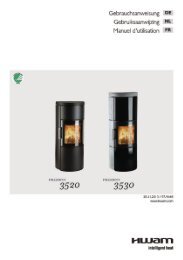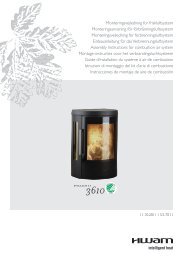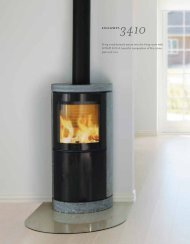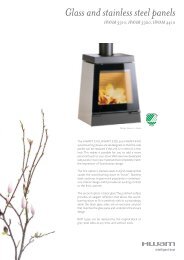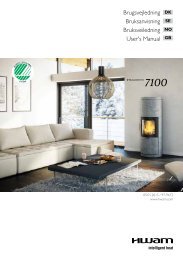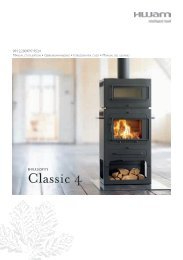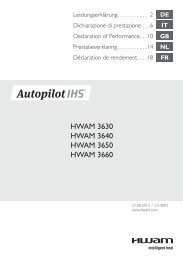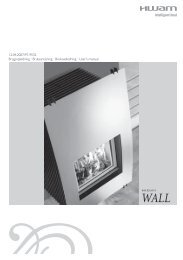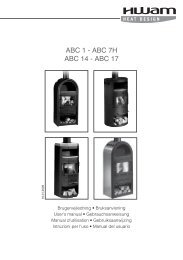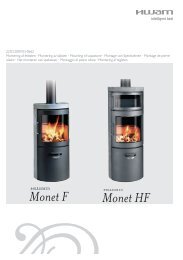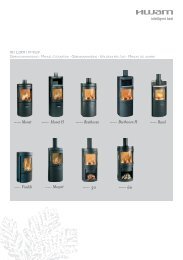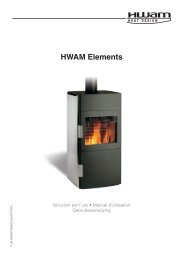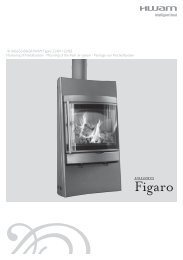prøvningsattest - Hwam
prøvningsattest - Hwam
prøvningsattest - Hwam
Create successful ePaper yourself
Turn your PDF publications into a flip-book with our unique Google optimized e-Paper software.
Vertical cross-section of smoke flue (Drawing B and C)<br />
B: Top smoke outlet C: Rear smoke outlet<br />
• Steel chimney (9).<br />
• Flue gas elbow (10). Fits into smoke flue socket.<br />
• Brick-built jamb of flue (11).<br />
• Built-in pipe sleeve (12). Fits smoke flue.<br />
• Wall rosette (13). Covers disruption to wall around pipe sleeve.<br />
• Joint (14). Sealed with packing material.<br />
• Smoke outlets (15) of the HWAM stove.<br />
• Smoke flue regulating damper (16).<br />
• Soot door (17).<br />
Fitting the loose parts<br />
Before the stove is installed, you must ensure that all loose parts are fitted correctly.<br />
Vertical cross-section of the stoves (Drawing B):<br />
• The smoke shelf (5): Should rest on the rear plate and on the stand uppermost in the front of the<br />
combustion chamber.<br />
• The baffle plate (6): Is suspended on two hooks, one in either side uppermost in the combustion chamber.<br />
To mount the baffle plate, lift it to a position at the very top of the combustion chamber, and then push<br />
it back until it falls into place in the two hooks. When the stove is installed, the transport protection is<br />
removed. Lift the smoke shelf up and forward. Then lower it and remove it from the combustion chamber.<br />
Subsequently, the transport protection is bent downwards/forwards until it is vertical.<br />
• The cast iron bottom plate (7): Must be in a flat position at the bottom of the combustion chamber.<br />
Chimney<br />
The chimney is the “engine” of the stove and it is crucial for the functioning of the woodburning stove.<br />
The chimney draft provides a partial vacuum in the stove. This vacuum removes the smoke from the stove,<br />
sucks air through the dampers for the so-called glass pane rinse which keeps the glass free of soot, and<br />
sucks in air through both primary and secondary dampers for the combustion.<br />
The chimney draft is created by the differences in temperature inside and outside the chimney. The higher<br />
the temperature within the chimney, the greater the draft. It is crucial, therefore, that the chimney is warmed<br />
up properly before closing the damper and limiting the combustion in the stove (a brick chimney takes<br />
longer to warm up than a steel chimney). On days where the weather and wind conditions create insufficient<br />
draught inside the chimney, it is even more important to warm up the chimney as quickly as possible. The<br />
trick is to quickly get some flames going. Split the wood into extra fine pieces, use an extra firelighter, etc.<br />
If the stove has not been used for a longer period, it is important to check that the chimney pipe is not<br />
blocked.<br />
It is possible to connect several devices to the same chimney. However, it is important to first check the<br />
applicable rules.<br />
Even a good chimney can function badly if it is not used correctly. Similarly, a bad chimney may function<br />
well if used correctly.<br />
Chimney sweeping<br />
To prevent the risk of chimney fires, the chimney must be cleaned every year. The flue duct and the smoke<br />
chamber above the baffle plate must be cleaned together with the chimney. If the chimney is too tall to<br />
be cleaned from above, it must be equipped with a soot door.<br />
In case of a chimney fire, close all dampers and call the firefighters. Before any further use, have the<br />
chimney checked by the chimney sweeper.<br />
36



